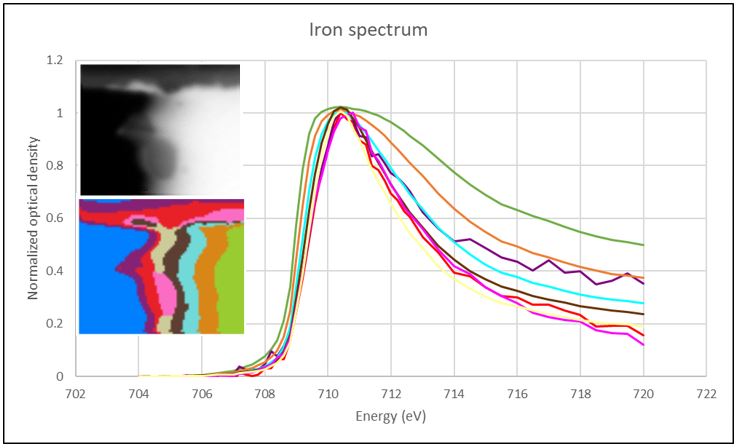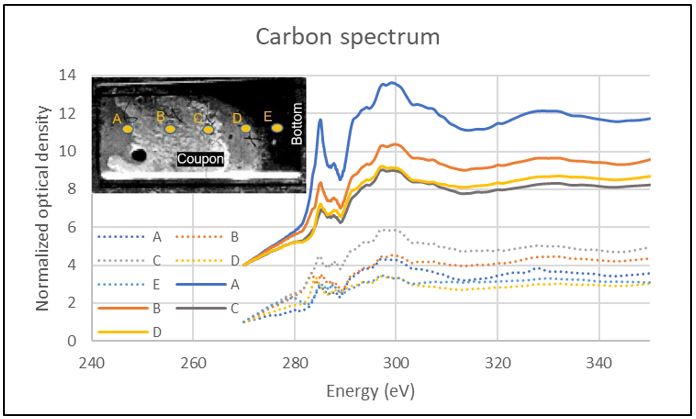(45c) Combined Xpeem and Stxm Study of Coke Formation on High Temperature Al-Containing Alloy during Steam Cracking of Ethane
AIChE Spring Meeting and Global Congress on Process Safety
2020
2020 Virtual Spring Meeting and 16th GCPS
Fuels and Petrochemicals Division - See Also The 32nd Ethylene Producers Conference, 20th Topical Conference on Gas Utilization, and 23rd Topical Conference on Refinery Processing
Developments in Aromatics and C3-C5 Petrochemicals II
Tuesday, August 18, 2020 - 2:15pm to 2:30pm
Keywords: ethane steam cracking, high-temperature alloys, coke formation, scanning transmission X-ray microscopy, X-ray photoemission electron microscopy
Steam cracking of hydrocarbons is still one of the most vital chemical processes for the production of many key building blocks of the chemical industry. Almost 200 million tons of ethylene are produced globally per year, underlining the process significance [1]. During the steam cracking process, carbonaceous deposits develop on the inner wall of the tubular reactors due to high carbon activity, a process known as carburization. This reduces the cross-sectional area of the reactor, leading to pressure drop, and obstructs the heat transfer from the furnace to the reactor. With suitable pretreatment/oxidation of the material, the lifetime of the coil can be increased by creating an effective oxide barrier and thereby achieving reduced coking rates [2].
Limited information is available on these carbonaceous deposits on the reactor wall and their composition from the surface of the alloy to the bulk. Characterizing these materials requires adequate sensitivity and detection limits for the light carbon to be separated from the heavier metal elements. In view of this goal, soft X-ray techniques giving access to the light C element, are ideally suited to solve these scientific questions. Two such complimentary techniques, Scanning Transmission X-ray Microscope (STXM) and X-ray PhotoEmission Electron Microscope (XPEEM), were used at the HERMES beamline of the SOLEIL synchrotron in Saint-Aubin, France, to detail the alloy carburization process.
The coked materials were produced in the thermogravimetric unit, which allowed evaluating on-line the coking behavior of a fresh vs. pretreated coupon from Al-containing high-temperature reactor materials. The steam cracking experiments consisted of five cracking cycles with four hours ethane cracking at 950°C, followed by ramping-up to 1050°C for two hours per cycle, the latter resembling the end-of-run industrial conditions.
To understand the effect of pretreatment on the rate of coke formation of these Al-containing alloys (coupons) during steam cracking of hydrocarbons, off-line STXM, XPEEM and SEM-EDX measurements were performed on the coked samples. The objective of these experiments was to study the elemental distribution of carbon on/in the alloy matrix, as well as the elemental speciation for carbon and its main alloying constituents (Fe, Ni, Cr, Al) with nanoscopic spatial resolution (~40nm). For STXM, samples need to have a thickness of less than 100 nm with a depth of 30 µm, while tracking orientation. Three different techniques were applied to make such samples out of the coupon: FIB-SEM, microtome slicing and electropolishing. While the latter only leads to bulk coupon samples, FIB-SEM could deliver wedges, meeting all STXM requirements.
Figure 1 Images based on averaged x-ray absorption signals from the stack of the bottom of the pretreated steam cracked Al containing coupon for a: C K edge (~285 eV) , b: Cr L3 edge (~575 eV), c: Ni L3 edge (~853 eV) and d: Fe L3 edge (~707 eV).
From the FIB-SEM samples, X-Y-I-E stacks (XY position, Intensity, Energy) were acquired for 4 elements, C K, Cr L3, Fe L3 and Ni L3 edge, allowing to come to element mapping in the thin zone of the wedge. Concentration maps were obtained by averaging a set of images above and below an X-ray absorption edge, providing an improved signal to noise ratio. Figure 1 shows the result for C, Cr, Ni and Fe. As these images were made based on the X-ray absorption signal slightly above the element’s edge, brighter intensity reflects more of this element is present. As such, a particle with higher Cr content is clearly visible at this position.
Figure 2 Normalized Fe L3 optical density graphs vs. x-ray energy produced from STXM on the pretreated steam cracked Al containing coupon. Inset: STXM image of the coupon wedge near the bottom and concommittant PCA cluster analysis for the Fe L3 edge using MANTiS software. The spectrum color is equal to the color of the cluster.
Figure 2 shows the normalized Fe L3 edge spectra obtained from STXM analysis of Figure 1d (inset) for a pretreated, steam cracked Al containing coupon. The stacked image 2.5 µm2 with a step size of 25 nm was processed using PCA-based cluster analysis to identify clusters or zones with significantly different Fe L3 signals. Each signal pertains to a cluster or zone of the image and will differ by a combination of varying sample thickness and chemical speciation of the element in that zone. These measurements are analyzed from the surface to the bulk (up to ~5µm) of the coupon.
In contrast to the transmission experiments of STXM, XPEEM looks at the emitted electron yield, hence with high surface sensitivity (probing depth: few nm). For the steam cracked coupon with and without pretreatment, such surface analysis was performed on 4 or 5 different positions along the coupon surface, to assess the difference in coking behavior of untreated vs. pretreated coupons. Figure 3 shows the curves obtained at the C K edge at 4 or 5 positions on both samples. Similar curves were recorded for the Ni L3, Fe L3, Cr L3 and O K edge and will be analyzed in parallel to correlate the results.
Figure 3: optical density curves acquired at the C K edge from the surface of steam cracked (dotted lines) and pretreated+steam cracked (solid lines) Al containing coupons, at different surface positions. Inset: SEM image of the non-pretreated steam cracked coupon with indication of the acquisition positions.
The results based on coking rates and SEM with EDX indicates that with the applied pretreatment conditions, the internal oxidation of alumina can be avoided and therefore coking rates are reduced by a factor 4 compared to non-pretreated coupons.
References
1. ExxonMobil, The Outlook for Energy: A view to 2040. 2012.
2. Sarris, S.A., et al., Optimization of the in-situ pretreatment of high temperature Ni-Cr Alloys for Ethane steam cracking. Ind. Eng. Chem. Res., 2017.
Checkout
This paper has an Extended Abstract file available; you must purchase the conference proceedings to access it.
Do you already own this?
Log In for instructions on accessing this content.
Pricing
Individuals
2020 Virtual Spring Meeting and 16th GCPS
| AIChE Pro Members | $150.00 |
| Employees of CCPS Member Companies | $150.00 |
| AIChE Graduate Student Members | Free |
| AIChE Undergraduate Student Members | Free |
| AIChE Explorer Members | $225.00 |
| Non-Members | $225.00 |
Fuels and Petrochemicals Division - See Also The 32nd Ethylene Producers Conference, 20th Topical Conference on Gas Utilization, and 23rd Topical Conference on Refinery Processing only
| AIChE Pro Members | $100.00 |
| Fuels and Petrochemicals Division Members | Free |
| AIChE Graduate Student Members | Free |
| AIChE Undergraduate Student Members | Free |
| AIChE Explorer Members | $150.00 |
| Non-Members | $150.00 |



